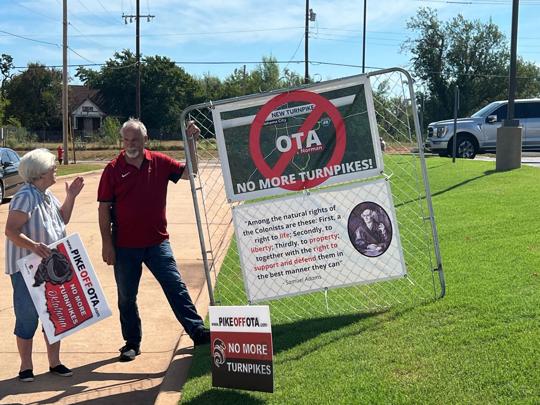
Oklahoma, you have a turnpike problem: Part 1
**Originally written and published by Katherine (Tassie) Hirschfeld, Ph.D., in the Oklahoman on April 26, 2022. Updated December 2022 and re-printed here with permission of author.**
Oklahoma, you have a turnpike problem. It is not a partisan problem. It affects citizens of all political affiliations. It is not a NIMBY (Not-In-My-Back-Yard) problem. The state Turnpike Authority puts all Oklahomans in harm’s way, not just those who live in the proposed path of the planned Access Oklahoma highway extensions.
The heart of the problem is that the Oklahoma Turnpike Authority is allowed to use government power to seize private property for private gain. The Agency does not receive state or federal money, which means it can sidestep environmental impact assessments, and keep many of its records hidden from view. But OTA is also part of state government and is planning to use its powers of eminent domain to seize hundreds of family homes and thousands of acres of scenic rural land to build new highways. Unlike other public agencies, OTA operates without public input and has no mandate to create public good. In its current configuration the OTA answers only to the governor, a small group of businessmen appointed by the governor, and the undisclosed investors who purchase its bonds. This combination of traits—unlimited power to take private property without sufficient transparency or accountability—allows OTA to engage in predatory practices that weaken civil society and undermine the rule of law.
The highways constructed by the Turnpike Authority are toll roads and all Oklahomans have to pay to use them. Most states use public funds to build free roads. But Oklahoma makes its citizens pay many times over for the privilege of driving from point A to point B. The state now has the second highest number of toll roads in the country and is planning to build many more. Some of these roads do not earn enough in revenue to recover the costs of construction.
Who benefits from Oklahoma’s toll roads to nowhere? A review of OTA’s 2021 budget document reveals the primary beneficiaries appear to be OTA executives (who earn some of the highest salaries in state government) and their cronies in the banking industry. Almost half of the Agency’s toll revenues for the next twenty-five years are allocated for debt service payments. For its current loans, OTA will pay over $1 billion in interest by 2048.
The recently announced Access Oklahoma plan will increase the Turnpike Authority’s debt by an additional $5 billion. The total payback amount (principal and interest) for these new bond debts will be at least $10 billion, depending on how much interest rates rise in the coming months. Bankers obviously love the Access Oklahoma plan. They will get fat fees for issuing bonds together with billions in interest payments. And if OTA gets in financial trouble and can’t make its scheduled payments, banks will be happy to let the Agency refinance and extend the life of the loans for decades to come. In fact, that is exactly how the OTA ended up with its current $2 billion debt load. It has refinanced its earlier bond debts many times over, so that Oklahomans can keep paying tolls forever.
Is any of this good for the citizens of Oklahoma? Should hundreds of Oklahoma families be forced out of their homes for the sake of toll roads that will tear apart rural communities and create a massive sinkhole of debt? These are questions all Oklahomans should be asking themselves and their elected representatives. If the answer is a unanimous NO (the way it has been here in the city of Norman), then the state’s transportation agencies must be reconfigured so that the predatory land grabs and irresponsible borrowing can finally be stopped.




